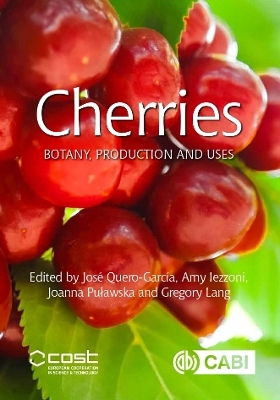
Cherries
CABI Publishing (Verlag)
978-1-78064-837-8 (ISBN)
Sweet and sour cherries (Prunus avium and Prunus cerasus) are important fruit crops for which demand is high and growing. A significant number of new varieties, rootstocks and training systems have been released or developed in recent years in order to improve the efficiency and profitability of cherry orchards. Cherries: Botany, Production and Uses covers the genetics, ecophysiology, production, protection and uses of cherries. Presenting up-to-date scientific data and applied information, this book is invaluable for researchers, teachers and all professionals working in the cherries value chain.
José Quero-Garcia (Edited By) José Quero Garcia entered Polytechnic University of Madrid in 1993 to obtain title of 'Agronomic Engineer' (2000). 1997-1998 Erasmus student at University of Reading (6 months). 1998-2000 studied at 'Institut Agronomique National Paris-Grigon' (INAP-G) within frame of double diploma exchange programme between ETSIA and INAP-G and obtained diploma of 'Ingénieur Agronome' from INAP-G. During last year at INAP-G, followed a DEA ('Diplôme d'Etudes Approfondies'), equivalent of an MSc degree, specialized in 'Genetics and Plant Breeding'. 2000-2004 worked at CIRAD obtaining the PhD degree at the 'Ecole Nationale Supérieure Agronomique de Montpellier' (ENSAM) in 2004. Worked on the study of diversity and breeding of taros (Colocasia esculenta) from Vanuatu. 2005 awarded a competitive fellowship ('Juan de la Cierva') from Spanish Ministry of Education and Research to conduct post-doctoral fellowship at ETSIA Madrid, working on Plant Virology. Before finishing post-doc, hired by INRA-Bordeaux in 2007, as permanent researcher, with main responsibility of leading the sweet cherry breeding programme at INRA. The focus of his team A3C ('Adaptation du Cerisier au Changement Climatique') is to study the adaptation of sweet cherry to climate changes, with a special emphasis on phenology-related traits as well as fruit quality, and in particular, tolerance to rain-induced cracking. Scientific interests include the study of genetic and molecular determinisms of traits of major agronomic importance for sweet cherry. Main applied objective is to implement marker-assisted strategies to optimize the current breeding programme. Since 2012, Chair of COST Action FA1104 'Sustainable production of high-quality cherries for the European market'. Gregory Lang (Edited By) Gregory Lang has been a professor of tree fruit physiology at Michigan State University (MSU) and program leader for the stone fruit physiology laboratory since 2000. He was previously an associate professor and program leader for the sweet cherry physiology laboratory at Washington State University from 1994-2000 and an assistant/associate professor of pomology at Louisiana State University from1987-1994. He earned a B.S. degree in horticultural science from University of Georgia and an M.S. in pomology and Ph.D. in plant physiology from University of California-Davis. His areas of expertise include tree fruit horticulture (development and management of sustainable orchard systems - pruning, training, growth regulation, and protective orchard covering systems, with particular emphasis on sweet cherry), tree fruit physiology (environmental stress, developmental and reproductive physiology, carbohydrate and nitrogen partitioning and utilization), and Prunus germplasm improvement and evaluation. Dr Lang has authored more than 185 research and industry articles related to fruit production, released or co-released five new sweet cherry varieties, and has edited or co-edited several books and proceedings on cherry research. Under the auspices of the International Society for Horticultural Science, he has served as the chair of international working groups on cherry production and orchard systems, and has provided numerous keynote addresses at scientific and grower conferences around the world. He is the recipient of the American Society for Horticultural Science's Undergraduate Research award (1981), Graduate Educator Award (2010), and Extension Materials award (2017), as well as the International Fruit Tree Association's Distinguished Research award (2001).
Part I: Genetic Resources and Improvement 1: Cherry Production 2: Flowering, Fruit Set and Development 3: Biodiversity, Germplasm Resources and Breeding Methods 4: Sweet Cherry Varieties and Improvement 5: Sour Cherry Varieties and Improvement 6: Rootstocks and Improvement Part II: Ecophysiology and Production 7: Rain-Induced Cracking of Sweet Cherries 8: Climatic Limiting Factors: Temperature 9: Environmental Limiting Factors for Cherry Production 10: Site Preparation and Orchard Infrastructure 11: Orchard Microclimate Modification 12: Morphology, Cropping Physiology and Canopy Training Part III: Protection 13: Invertebrate and Vertebrate Pests: Biology and Management 14: Fungal Diseases 15: Bacterial Diseases 16: Viruses, Viroids, Phytoplasmas and Genetic Disorders of Cherry Part IV: Utilization 17: Fruit Chemistry, Nutritional Benefits and Social Aspects 18: Fruit Harvest Methods and Technologies 19: Postharvest Biology and Handling for Fresh Markets 20: Processing for Industrial Uses
| Erscheinungsdatum | 02.02.2017 |
|---|---|
| Reihe/Serie | Botany, Production and Uses |
| Co-Autor | Marlene Ayala |
| Verlagsort | Wallingford |
| Sprache | englisch |
| Maße | 172 x 244 mm |
| Gewicht | 1537 g |
| Themenwelt | Naturwissenschaften ► Biologie ► Botanik |
| Weitere Fachgebiete ► Land- / Forstwirtschaft / Fischerei | |
| ISBN-10 | 1-78064-837-5 / 1780648375 |
| ISBN-13 | 978-1-78064-837-8 / 9781780648378 |
| Zustand | Neuware |
| Haben Sie eine Frage zum Produkt? |
aus dem Bereich


